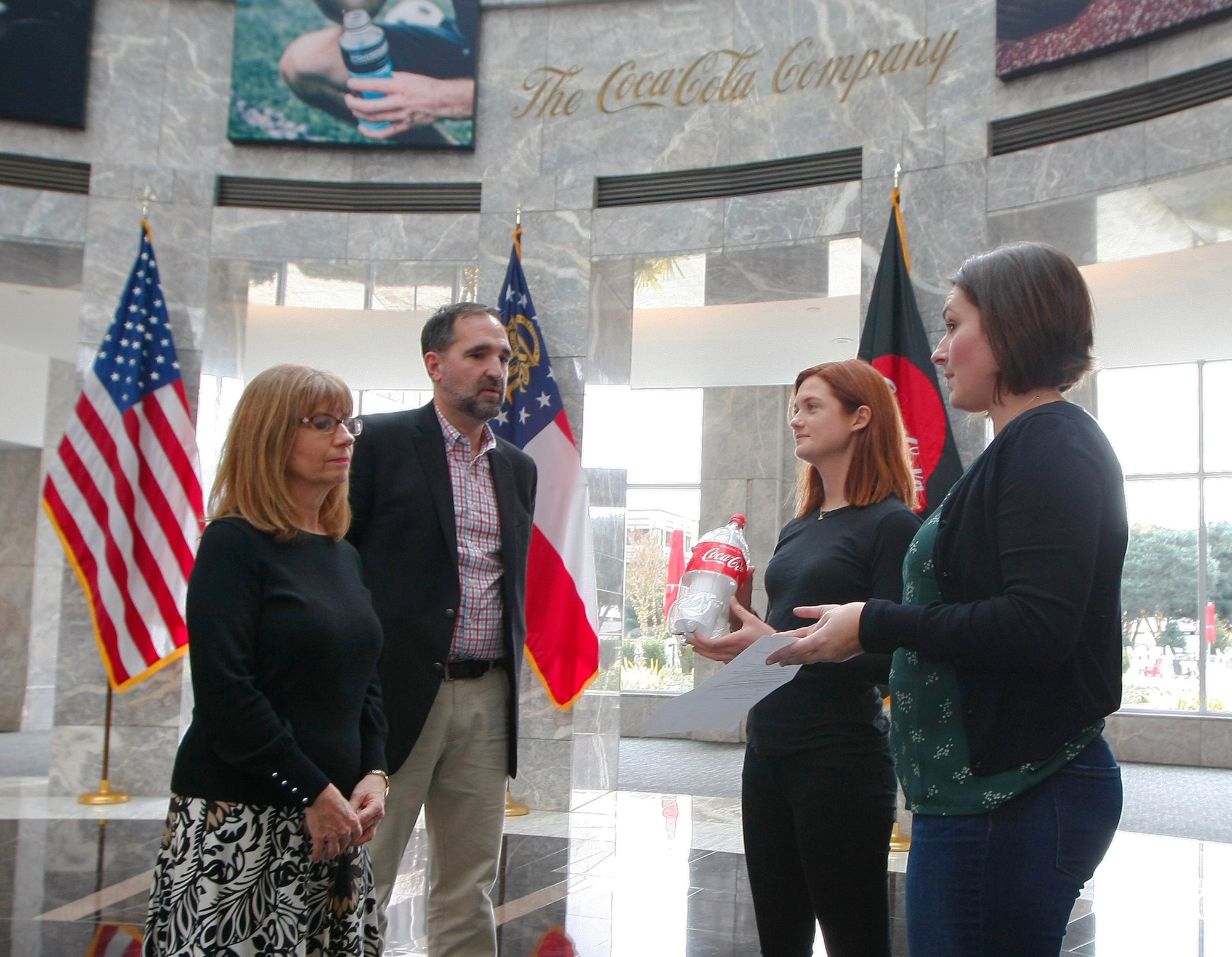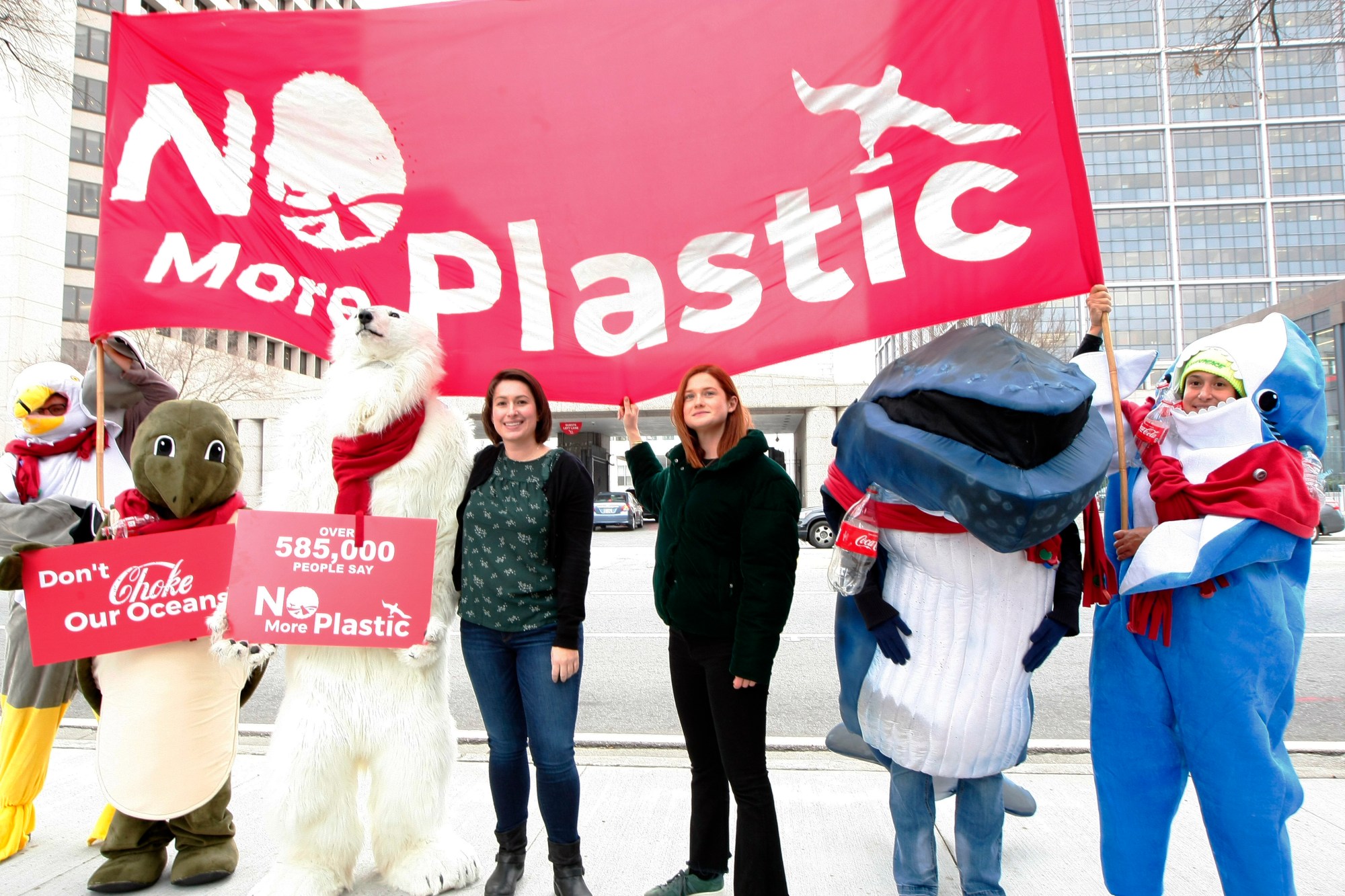Ever get overwhelmed by the amount of shocking images of trash covered beaches or videos of turtles choking on plastic straws circulating the internet, but have no idea how to take serious action? I certainly was! Over the past few months I’ve been partnering with Greenpeace to raise awareness around the plastic that pollutes our ocean. This journey has taken me from the blue waters of The Bahamas to the concrete jungle of Coca-Cola’s headquarters in Atlanta.
I have been so inspired by the ever growing environmentally conscious global community and people’s desire to take action. I truly believe there is no planet B, I am fascinated by what lies within our solar system but at the end of the day this is our home and we should be doing everything we can to protect its beauty and abundance. I have pulled together 10 actions you can take and integrate into your day-to-day life, from bamboo toothbrushes to suck-free cocktails.

1. Reusable, reusable, reusable!
Invest in a reusable water bottle and coffee cup, or even use an old jam jar or glass bottle. This is an easy and effective way to lessen your plastic waste. You will stay hydrated and save money from not buying plastic water bottles. In fact, why not take one step further: Tomorrow when you order your coffee ask to speak with the manager about their sustainability initiatives. A few ideas for questions to ask are, what are you already doing as a cafe to waste less and be more sustainable? Don’t assume they have already started taking steps towards sustainability. What type of packaging do you use? Is it made from recycled materials, is it compostable, do the paper cups actually contain plastic lining (most do)? Suggest they start an initiative program where customers receive a 25p discount when they bring their own reusable cups. Then suggest they ban plastic-straws, which leads me onto my next action…
2. Straws, dreaded straws.
Let’s be honest we don’t need to use a straw, we can quite easily sip beverages with our lips. But if you, like Beyonce want to keep your lipstick in tact whilst performing on stage to 90,000 people you can use a reusable metal or glass straw. I particularly like copper ones, as copper has antibacterial properties. The whole “Oh but they gave me a straw, I didn’t ask for one” will not suffice. Do not consider yourself difficult by punctuating every drinks order with, “No plastic straw please, I am trying to be eco-friendly and avoid single-use plastic”. Your barman or barista may then be inspired to ask the next customer if they would prefer no straw. Remember always say thank you to those who respect your request, we want them to like straw-free customers. If the Wetherspoons chain of pubs are already onto the straw-free movement, so should your local.
3. Petitions!
Everyday there’s a new petition to sign; I get it, it can be overwhelming. But last week the power of petitions was solidified for me as Coca-Cola agreed to meet us at their global headquarters in Atlanta and personally accept the petition that we at Greenpeace had written with the help of over 585,000 people globally to urge them to phase out their use of single-use plastic bottles. So petitions do work, are a powerful tool and take seconds to sign. You may even have a specific angle around an issue that you would like to push. Ever thought of making your own petition? GreenpeaceX is a platform that allows you to start, run and deliver your own campaign.
4. Customer Power.
We may indeed live in a world that feels like corporations are king, but we do have to remember that we are the customer and we have the power of choice where to spend our money. So next time you are in an aisle at the supermarket and you are choosing which variation of crunchy, creamy, dark roast, light roast peanut butter to buy you should first be looking at the packaging choices, is it a plastic or glass container, does it have a plastic lid or tin lid? If you find your local supermarket is not cutting it and you want to buy more products in bulk using your own containers, this website lists stores in the UK that you can shop waste free .
5. Don’t forget to brush your teeth.
Remember first learning to brush your teeth? Yes, it was boring, but do you actually remember your very first toothbrush? Well, that very same toothbrush still exists in some form on this planet somewhere! Something produced in plastic can never ever truly disappear. Now I am not asking you to stop brushing your teeth because, gross. Instead my suggestion is to go buy yourself a bamboo compostable one and your molars will never look back! Now, you’re probably thinking, “Shit what about the plastic tube of toothpaste I am using?” Well, I can help you there too. Or rather, you can help yourself by making your own toothpaste. My friend Danielle Copperman has a great recipe using just two ingredients in her new book, Well Being: Rituals and Recipes to Realign the Body and Mind. To make a jar with 20 brushes worth of toothpaste simply mix 6 tablespoons of activated charcoal powder with 1 teaspoon of baking powder. Then dip your wet toothbrush into the your mix and voila, a morning and night routine using zero plastic. Make sure when you buy your ingredients to make your products, that you buy from companies that use glass not plastic for their bottles.

6. Wash your clothes without staining the ocean.
It is terrifying how many bottles of laundry detergent and shampoo we get through in a lifetime. So you can get a visual of just how much plastic you consume in a year, calculate your plastic footprint here. Shocked? I certainly was. A few ideas on how to reduce this: make your own multi-surface cleaning product; next time you finish a bottle of cleaner don’t “recycle” it, reuse it; Fill it halfway with water, the other half with distilled white wine vinegar and then 20 drops of essential oil for a nice scent, I personally love lavender.
7. Ladies, ladies!
I estimate that a tampon weighs about 15g, so say we use 300 a year for 35 years, that’s 158kg or 350lbs of waste from menstrual products in our lifetime. Fear not, there are many different options on the market to reduce this terrifying figure. First, you could start by switching from the plastic covered Tampax to biodegradable non-toxic tampons, from companies like Natracare, Cottons and many others that are available at your local Boots. Then slowly start experimenting with reusable, washable padded underwear, there are so many great shapes and designs available from companies like Thinx and Pretty Clever Pants. There’s also the menstrual cup, again many different variations from the Moon Cup to the Diva Cup. You can even use totally natural Sea-Sponge tampons, that you rinse after every use. I have yet to try these!
8. Back it up, don’t bag it up.
Most of us, either through our awareness of the environment or preference, choose not to spend an extra 5p on a plastic bag and now carry our own canvas reusable shopping bags. To take this action further, when you reach for your fruit and vegetable at the supermarket choose the loose kind (no cartons) and do not take a thin, totally un-recyclable plastic bag to put them in. Most fruit and vegetables have a natural protective layer of waxy skin or can be washed when you get them home, they do not need an extra manmade totally useless, totally harmful plastic layer around them. Also, when you take that lemon home and slice a wedge out for a drink, do you really need to wrap it in cling film or could you just put it in a reusable Tupperware or even leave to chill in the refrigerator sans cover. I think so.
9. Meat free Mondays
While I am not asking you to go vegan (although, you could think about it), I do believe that a varied and balanced diet is best for the environment. Say hello to meat free Mondays, one day a week where you focus your meals around local fruit and vegetables of that season. You can thank the McCartney family for this gem. Speaking of fruit and veg, it’s always good to look at where they’re grown, did they travel by truck or plane? If you’re in the UK try and limit your purchases to Spain, and if you’re in the US limit it to your country.
10. Use less
This is more of a way of being day-to-day rather than a specific action. But if you just stop for a moment and think about how many times you interact with plastic in your day, you will be surprised with just how much you consume. Think twice before going out to buy your lunch in takeout packaging, could you make your own lunch or cup of coffee at the office? Before buying another T-shirt because the one you love has a teeny tiny hole in it, could you not darn it and save the money and the waste? The fashion industry is one of the largest contributors to waste in the world. But that’s another article…
I hope this list had not overwhelmed you, but instead inspired you to take an action today. Remember to lead by example and not by force.
Join me and the global Greenpeace community here.
